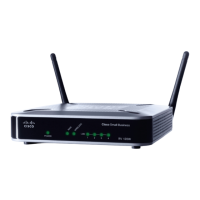Configuring Networking
Configuring the Local Area Network (LAN)
Cisco RV 120W Administration Guide 36
2
• PAP—The Cisco RV 120W uses Password Authentication Protocol when
connecting with the ISP.
• CHAP—The Cisco RV 120W uses Challenge Handshake Authentication
Protocol when connecting with the ISP.
• MS-CHAP or MS-CHAPv2—The Cisco RV 120W uses Microsoft Challenge
Handshake Authentication Protocol when connecting with the ISP.
STEP 5 Choose the connectivity type:
• Keep connected—The Internet connection is always on.
• Idle Time—The Internet connection is on only when traffic is present. If the
connection is idle—that is, no traffic is occurring—the connection is closed.
You might want to choose this if your ISP charges based on the amount of
time that you are connected.
If you choose this connection type, enter the number of minutes after which
the connection shuts off in the Idle Time field.
STEP 6 Click Save. Your new profile is added to the list.
Configuring the Local Area Network (LAN)
For most applications, the default DHCP and TCP/IP settings are satisfactory. If you
want another PC on your network to be the DHCP server, or if you are manually
configuring the network settings of all of your PCs, disable DHCP.
Instead of using a DNS server, you can use a Windows Internet Naming Service
(WINS) server. A WINS server is the equivalent of a DNS server but uses the
NetBIOS protocol to resolve hostnames. The router includes the WINS server IP
address in the DHCP configuration when acknowledging a DHCP request from a
DHCP client.
You can also enable a DNS proxy. When enabled, the router then acts as a proxy
for all DNS requests and communicates with the ISP's DNS servers. When
disabled, all DHCP clients receive the DNS IP addresses of the ISP.

